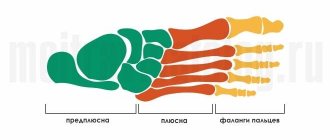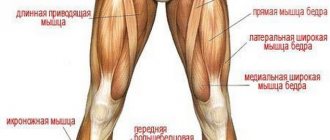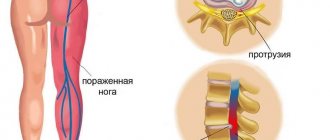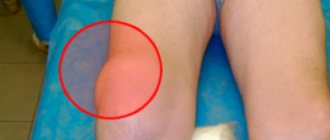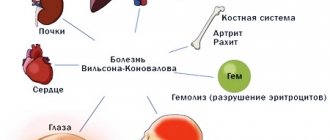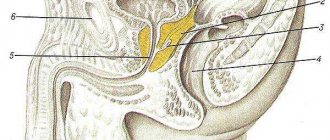Numbness of the first toe is a problem that is not given much importance. But paresthesia can be both a temporary inconvenience and a sign of a dangerous disease. Sometimes the symptom occurs at night, with the toe tingling and a “crawling” sensation in the forefoot. Most often, it is enough to rub or massage the foot, spread your fingers out to the sides several times and then squeeze them together, hold the limb in warm water, after which normal sensitivity returns.
But this doesn't always happen. If your big toe periodically goes numb, the sensation does not go away spontaneously, and over time the symptom progresses (occurs more often, covers an increasingly larger area), you should consult a doctor for an examination and diagnosis.
Causes of numbness
In healthy people, sensitivity to thermal and physical effects should remain full. Often, problems with sensitivity in the lower extremities occur with vascular disorders and nerve endings. The most common causes of numbness in the big toe are:
- Osteochondrosis.
- Gout.
- Inflammation in the joints.
- Vascular diseases in the lower extremities.
- Using uncomfortable shoes.
Girls often wear boots that are the wrong size. Unpleasant sensations in such situations worsen at the end of the day and subside in the morning.
To eliminate this unpleasant condition, you need to walk around in comfortable shoes for a couple of weeks, the sensitivity of such fingers is fully restored.
Preventive measures
Simple recommendations will help reduce the risk of numbness:
- The right choice of shoes: they should be the right size with small heels. High heels and narrow socks are prohibited;
- Wear shoes appropriate for the season, wear warm socks or tights. Choose a model with thick soles;
- Get rid of the habit of sitting cross-legged. This position not only provokes loss of sensitivity in the lower extremities, but also leads to venous insufficiency and varicose veins;
- If pathological symptoms occur, you should immediately seek medical help.
Self-medication of numbness is unacceptable. This can trigger the progression of systemic disease and cause the development of dangerous complications or disability. Only a qualified doctor can make a diagnosis and prescribe treatment after a comprehensive examination.
Osteochondrosis
When, in addition to numbness, a person is bothered by other symptoms, it is necessary to undergo a comprehensive analysis. Defects in the normal structure and function of the spinal column negatively affect the ability to perform body movements and innervation. Complex trophic transformations are carried out in them. This causes a disorder in the intervertebral discs or the appearance of hernias that compress the nerve fibers in the spinal region.
The nervous system in the lumbosacral region is responsible for sensitivity to the touch of the skin on the legs. If you have a disease in this area, your fingers may become numb.
If sensation in the big toe is lost, osteochondrosis can be diagnosed based on frequent, recurring pain in the lower back. You need to contact neurologists or orthopedists for examination. Often, pain symptoms are transmitted to the leg, thus deteriorating sensitivity, deteriorating nervous regulation and the blood supply mechanism. Complex treatment of the disease is required; if the pathological condition develops, surgery will have to be performed.
Gout
In many patients, the thumb may become numb due to poor metabolism. Gout is characterized by disorders in the metabolism of uric acid. The disease has specific symptoms.
Gouty arthritis is considered one of the types of pathologies. With this form of the disease, joints with gouty nodes appear. Damage to the big toes often occurs. The joints of the hands and other body parts are involved in the pathological process.
More about symptoms
It will be possible to determine why the big toes go numb by determining the location of the unpleasant tingling sensation and eliminating sensitivity:
- If sensitivity worsens in one leg and pain in the lumbar region, the condition of the spine and cartilaginous formations must be taken into account. Protrusion and osteochondrosis are characterized by loss of sensitivity of the finger on the right.
- Pinching of the sciatic nerve is seen as numbness of the limb from the inside of the knee joint to the big toe.
- Polyneuropathy is characterized by a general deterioration in the sensitivity of the legs. The pathology can be triggered by intoxication, which causes a disorder of the peripheral nerves with poor conductivity of bioelectric impulses.
- Atherosclerosis and diabetes are also characterized by such numbness. In this situation, loss of sensitivity is observed throughout the entire plane of the foot.
At an appointment with a specialist, you need to explain the disturbing symptoms to him.
Treatment methods
After a comprehensive examination, the doctor will begin treatment.
Therapy is carried out in the following sequence:
- Localization of symptoms. For this purpose, drugs are prescribed that normalize blood circulation, muscle relaxants, painkillers and others, depending on the cause of the disease.
- If the problem is vertebrogenic processes, then vascular drugs and B vitamins are prescribed.
- Physiotherapeutic procedures.
- Massage.
- Physiotherapy.
- Acupuncture.
- Carrying out manual therapy. The sessions improve blood flow, and the connection between the peripheral nerves and the central system is restored.
If the cause of numbness is hidden in tired legs or incorrectly selected shoes, then to relieve the symptom the doctor will suggest:
- foot massage;
- warm compress;
- changing shoes to more comfortable ones.
Medications
Treatment depends on the underlying cause.
Some treatment options include:
| Disease | Therapy | Drugs |
| Diabetes | Antidiabetic drugs to prevent complications | Metformin Gliquidone |
| Peripheral vascular diseases | Vasodilators | Trental Persactin |
| Gout | NSAID drugs | Colchicine, prednisolone |
| Radiculopathy | Muscle relaxants to relieve spasms | Baclofen, Flexeril, Soma, Tylenol |
| NSAIDs | Motrin, Naproxen, Tylenol | |
| Vitamin deficiency | B vitamins | Binavit Pentavit |
Vitamin B12 can be obtained additionally by including milk, seafood, red meat, and fish in your diet.
Traditional methods
If the examination does not reveal serious causes of the disease, then you can try home treatment:
- Foot massage will improve blood circulation. For massage, take a little olive or sunflower oil and rub it in your palm. Massage with circular movements for at least 5 minutes.
- Massage with turmeric solution. Prepare a paste from water and 1 tsp. powder. Massage your finger in a circular motion, rubbing in the paste.
- Warming your feet with a heating pad or warm water will help relieve numbness. Soak a linen rag or washcloth in hot water, wring it out, cool slightly and apply to the affected area of the skin. Keep the fabric for 5-7 minutes. Repeat several times until the symptom disappears.
- Massage with primrose oil. Take 1–2 tsp. oil, apply to the thumb and massage gently for 15–20 minutes. Then rinse with warm water. Perform the procedure 2-3 times a day. The oil is an excellent source of amino acids, magnesium, iron and phosphorus. Has a calming effect on the nervous system.
- Massage with lavender oil. This is done in the same way as with primrose oil. Has an anti-inflammatory effect.
- Massage with mustard oil. Heat ½ cup oil in the microwave. Cool slightly, if too hot, rub it in your hand and massage it around your thumb. Leave the oil for 40 minutes, then rinse with warm water. Repeat the procedure 2-3 times a day.
- Soaking your finger in a bath with added Epsom salt. Mix ½ cup of salt with warm water, then place your foot in the solution for 10 minutes. The procedure can be repeated until the unpleasant symptom disappears.
- Honey wrap helps restore the activity of the finger. It can be done at night as a compress.
Drinks to help relieve numbness:
- Add 1 tsp. turmeric powder in a glass of milk. Heat the mixture, add a little honey. Drink once a day to improve blood flow.
- Dilute 1 tsp in a glass of milk. cinnamon without sugar. Drink the solution once a day.
- A drink based on cayenne pepper, ginger, garlic. Grind ½ tsp. garlic, ½ tsp. ginger, add 1 tsp. cayenne pepper. Mix everything. Heat 1-2 cups of water over a fire, add the dry mixture to it. Leave for 5–6 minutes. Strain and pour into a clean container. Drink the decoction 2-3 times a week until complete relief.
To relieve the unpleasant symptom, you should add foods containing magnesium to your diet: dark green vegetables, seeds, oatmeal, nuts, bananas. You can take 350 mg of magnesium supplements per day.
Physical exercises that should be performed every morning will help improve blood circulation and prevent numbness. Among the exercises of therapeutic gymnastics, tiptoe walking and finger exercises are especially useful.
Other methods
An additional technique aimed at restoring impaired blood circulation and relieving spasms includes physiotherapy:
- Electrophoresis using drugs.
- Magnetotherapy. Treatment with pulsed fields improves microcirculation and relieves inflammation.
Electrophoresis helps the drug penetrate deep into the legs, which is why it is often used in the treatment of numbness in the fingers - Ion therapy. A method of introducing medicinal substances into the body through the skin through ionogalvanization. The more superficial the painful area is, the better the effect of galvanic current on it.
At the next stage, the doctor will recommend massage and exercise therapy. These procedures are useful for pinched nerves and muscle spasms.
If numbness of the thumb is caused by a bulging disc, hernia, or spinal stenosis, then spinal surgery is performed depending on the location of the disease:
- laminectomy, minimally invasive surgery;
- microsurgical discectomy;
- foraminotomy, a minimally invasive procedure.
Alternative treatment methods include acupuncture and manual therapy. These procedures are indicated if numbness of the finger occurs due to osteochondrosis, sciatica, or disorders of the spine.
The toe (big) is numb, and if this is due to muscle atrophy and paralysis, the doctor will recommend physical therapy sessions.
When to be wary
Paresthesia may be accompanied by other signs indicating threatening conditions.
- Such signs include:
- The feeling of numbness is constantly replaced by pain.
- Paresthesia extends to the feet or legs.
- The skin turns blue.
- Sensitivity to temperature decreases with numbness.
- The gait has changed.
What do doctors recommend?
When numbness of the thumbs is caused by temporary factors, they need to be eliminated. You need to wear comfortable shoes that are not too tight. If people often face physical and static pressure, it is undesirable to neglect rest; they need to relax more often, perform massage procedures from time to time, take a contrast shower, and do sports exercises in sufficient quantities.
You need to give up coffee, alcohol, cigarettes, and ensure that your diet contains vitamins and minerals. You need to lead a correct and healthy lifestyle. When your thumbs go numb due to pathological processes, you cannot do without consulting a doctor. With such complaints, you should contact a doctor, who, upon examination and diagnosis, will refer the patient to a doctor:
- Neuropathologist.
- Endocrinologist.
- Traumatologist.
- Surgeon.
After a definite diagnosis, the specialist prescribes complex therapy, which involves treating the main disease causing numbness. The problem can be solved through symptomatic treatment.
Triggers for numbness in toes
Loss of sensation in the toes occurs as a result of an inflammatory process localized in the arterial vessels of the extremities. If blood circulation is impaired, this leads to gradual tissue necrosis, and as a result, the patient may end up in a medical facility with gangrene. Factors that can trigger an irreversible process are:
- Vitamin B12 deficiency in the body. This is an essential chemical that takes an active part in all metabolic processes of the human body. Its deficiency leads to the fact that a person may feel lethargic, tired and irritable throughout the day. In addition, cardiovascular disorders, which are also caused by vitamin B12 deficiency, affect the general condition of the body.
- Rhine's disease, which in 40% of clinical cases is the trigger for numbness of the toes.
- In turn, Rhine disease occurs as a result of hereditary factors, chronic alcoholism, and also after prolonged emotional stress. In some cases, nicotine addiction can be the main cause of both Rhine disease and paresthesia.
- Obliterating endarteritis implies damage to the arterial vessels of the lower extremities. This pathology is characterized by narrowing of blood vessels as a result of insufficient blood circulation. As a rule, the result of this disease is the occurrence of gangrene.
- A disease that affects the human nervous system called neuropathy. The reason for its occurrence lies in intoxication of the body and metabolic disorders in general. The main symptoms of the pathology are: burning of the toes, tingling, itching of the extremities. Pain usually occurs spontaneously.
- Ischemic disease.
- A constant state of panic and fear, a feeling of anxiety.
- A benign or malignant tumor of the spinal cord, which, as its structural size increases, puts pressure on the nerve endings and blood vessels.
Diagnostics
To prescribe appropriate therapy, it is necessary to conduct a comprehensive examination, thanks to which a full-fledged picture is revealed that provokes loss of sensitivity. Main diagnostic techniques:
- X-ray.
- Ultrasound.
- CT, MRI.
- Blood analysis.
A comprehensive examination makes it possible to correctly identify the cause of deterioration in sensation in the legs and tingling, and to determine appropriate medications that help neutralize the symptoms and have an impact on the cause.
What does a person feel?
Numbness (paresthesia) is experienced subjectively. For example, as one of the manifestations listed below, any combination or complete complex.
- Loss of sensation.
- Burning.
- Inability to move fingers or bend them.
- Tingling with thousands of “needles”.
- Goosebumps.
- Itching.
- Discomfort.
Whatever the sensation, if a person’s toes are numb, treatment should be preceded by an adequate examination that will help identify the underlying causes of the disease.
Therapy
Complex therapy is determined after determining the real cause of numbness. It involves other necessary activities:
- The use of medications or surgical intervention, due to which compression of the nerve roots is determined.
- Vitamin complexes stabilize metabolism and nerve fibers.
- Prescription of medications that reduce the number of cholesterol plaques. This type of drug is related to statins and helps regulate the concentration of cholesterol in the blood.
- Use of medications that affect the quality of blood circulation.
- Drugs that reduce the amount of salt deposits on joints.
Physiotherapy has shown positive results in solving the problem of numbness in the big toe.
Physiotherapeutic procedures include:
- Massage treatments.
- Applications using paraffin.
- Exercise therapy.
- Electrophoresis.
- Electrical stimulation.
- Mud containing many useful microelements.
- Contrast baths.
- Magnet.
In advanced situations, surgical treatment has to be practiced.
Therapeutic measures
Treatment recommended by a specialist may include:
- physiotherapeutic and massage procedures;
- Exercise therapy, manual therapy;
- health baths;
- laser, high-tone, shock wave therapy;
- use of orthopedic insoles or special shoes.
Surgery is required if diagnosed:
- significant curvature and deviation of the first finger in the direction of the second (protruding “bone”);
- protrusion of the nucleus pulposus (hernia) with complications;
- neoplasms in the spine;
- finger necrosis.
Drug therapy may include the use of B vitamins, corticosteroid hormonal drugs, NSAIDs, immunobiological drugs based on monoclonal antibodies, immunosuppressants (for autoimmune diseases), cytostatics (for cancer chemotherapy).
Alternative medicine methods are used (in consultation with the doctor): acupuncture, hirudotherapy. In the initial stages of hallux valgus, foot baths with saline solution or decoctions of medicinal herbs, compresses made from honey and cabbage are used. A contrast shower for the feet and rubbing with pepper or turpentine ointment are effective for numbness.
Prevention
Paresthesia is not considered a dangerous condition, but can cause complex problems; such a disorder is best prevented. Let's look at some useful tips:
- Don't sit in one position for a long time.
- If you need to walk or stand still for a long time, your shoes should be comfortable.
- The body requires hardening; you will need walks and sports activities.
- Avoid increased injury and physical strain.
- Adjust your diet, eat more vitamins, hot food.
- Regulate body weight, avoid obesity.
- Do not succumb to emotional stress.
This symptom is difficult to get rid of. You need to find out the cause of this condition and be more attentive to your health.
- Let's figure out what signs you need to see a doctor:
- Deterioration of sensitivity is replaced by pain.
- Paresthesia appears in the big toe, but spreads to the entire leg.
- The feeling as if the fingers were frozen does not go away all day.
- The skin turned white.
- Redness and swelling are observed.
- The gait changes.
- Loss of sensitivity to temperature.
If you experience numbness in your head, legs, or arms, you should consult a doctor.
Numbness of the big toe can occur for various reasons, varying in degree of complexity. Therefore, you should immediately consult a doctor if such signs occur. Only a doctor can determine the cause of numbness. Various changes towards a healthy lifestyle will be beneficial.
Recommendations for eliminating numbness of the limbs
If there is numbness in the limbs, the patient is advised to give up bad habits, in particular smoking. Nicotine is not only a poison that poisons the lungs, but also this substance causes vasospasm. Therefore, nicotine, alcohol, as well as strong black tea and coffee are strictly contraindicated for all those who suffer from numbness of the limbs.
Doctors also recommend changing your diet, namely focusing on hot dishes. Hardening the body, as well as constant movement and physical activity on the lower body are an indispensable aid for those who periodically experience loss of sensation in the limbs.
Traditional medicine recipes include taking contrast baths or showers, as well as warming your fingers with turpentine ointment. At night it is useful to make warming wraps using honey and camphor alcohol.
